CYCLISTS THAT BUY TIRES for the first time are often shocked at how expensive bike tires can be. It’s easy to spend $60+ on a single bike tire. The cost of a bike tire can be attributed to how it’s made, what it’s made of, and who makes it.
“Threads per inch” (TPI) is often mentioned when people talk about tires. A higher TPI can suggest a higher quality tire, but in practice, it usually doesn’t.
In bike tire-speak, a “thread” in this context is the fabric under the rubber tread. The fabric threads are layered over each other to form the basic shape of the tire before the rubber layer (tread) is added. Each layer of fabric is a “casing.”
For tires with a single casing, a higher thread count indicates a higher-quality and likely better-performing tire. Although often quoted, TPI is not a very helpful indicator of tire quality since some tire manufacturers advertise the sum of all TPI across multiple layers of casing to artificially inflate their TPI number. So, the first lesson of tire-buying, especially for commuter tires, is to ignore any sales pitch based on TPI.
The casings for the vast majority of tires sold today are made from nylon threads. The casings are woven by machines. On the other hand, super-fancy, high-performance casings are constructed with cotton threads and often hand-woven.
Casings are attached to either wire or Kevlar “beads,” which are the hoops that correspond to the wheel size and hold the tire under the small hook that runs along the inside of the rims on the wheels.
The rubber tread lives on the outside of the casing. Often, a thin layer of puncture-resistant material is sandwiched between the casing and the rubber tread. The sidewalls of the tires are often made of a different rubber compound than the “tread” of the wheel.
The makeup of the tread, sidewalls, and puncture-resistant material determine the three qualities commuters care about in their tires:
• PUNCTURE RESISTANCE: Tire manufacturers have two main weapons against punctures. They add a layer of Kevlar or other puncture-resistant material under the tread, and they can use harder rubber compounds for the tread and sidewalls.
• COMFORT: There are two main variables when it comes to comfy bike tires: volume (tire size) and the amount of stuff between the casing and the road. Big fat tires exemplify why John Dunlop invented the pneumatic tire to replace the wooden bicycle wheel. Puffy tires smooth out the bumps.
In addition, minimizing the number of layers in the tire and using supple rubber compounds for these layers makes for more comfortable tires, since the resulting tire will deform better around bumps and cracks on the road.
• PERFORMANCE: As with all bike-related performance theory, there’s no consensus on whether a rock-hard skinny tire will always out-perform a wider, suppler tire. Most tires are marketed around the concept of “rolling resistance,” where a given tire is rolled on a steel drum that can measure the amount of resistance on the tire. Given this method, it’s no surprise that rock-hard skinny tires have less rolling resistance than higher-volume, more supple-tires. And if the streets of Spokane were paved with smooth stainless steel, there would be no question of which style of tire to ride. But roads are imperfect, bumpy, pot-holey and cracked. In the last few years, enthusiasts and at least one proper study have shown that in real-world conditions higher-volume, supple tires will out-roll their skinny, rock-hard counterparts.
So where does all of this leave the poor cyclist that just wants a stinking commuter tire that is moderately priced, adequately puncture proof, comfortable and fast enough?
The answer: the Panaracer Pasela Tour Guard. It’s about $30.
Buy the fattest width Pasela that you can fit in your bike.
The Pasela is the perfect balance of cost, flat-protection, comfort and performance. It has a fairly neutral tread that rolls fast enough on pavement yet provides just enough bite for non-technical dirt trails and roads. Any local bike shop can order them. And the good ones will have them in stock. //













